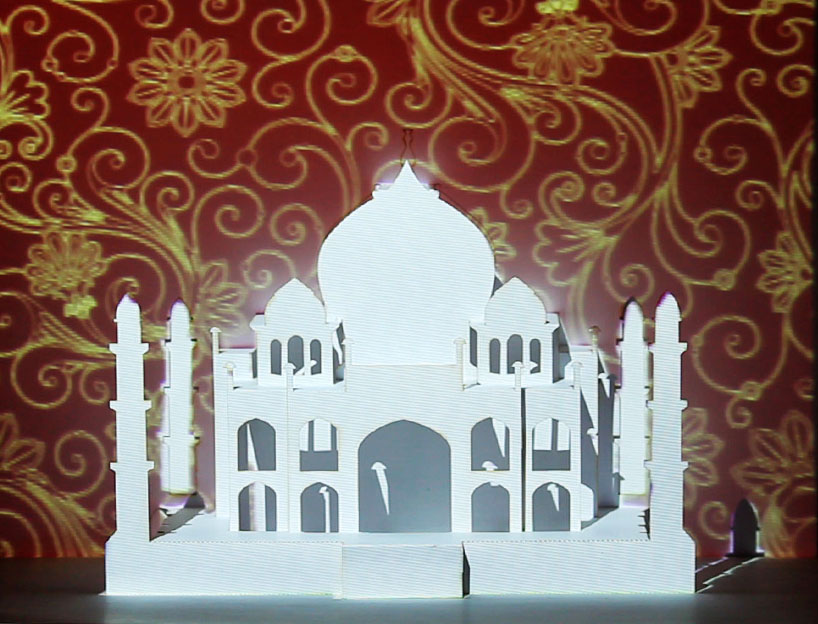
iconic architecture exploring mixed reality pop up books by manasi agarwal from india
designer's own words:
1. INTRODUCTION
The area of interactive installations for museums
and/or exhibits has seen a growing interest over
the past decade. Using technology in novel ways
for the purpose of information visualisation and
aiding understanding about a specific subject is
goal that drives many new media designers.
Projection mapping, or spatial augmented reality
(SAR) as it is called in the academia, is one
of the many new media that has generated a
lot of attention due to its extremely visual and
experiential nature. Architecture, with its 3D facade
and geometry provides infinite opportunity in the
area of spatial augmentation.
This project took the form of a pop-up book to
create an immersive narrative about architecture
and its history. The installation is a proposal for a
museum context and can be widely adapted across
various subjects and spaces. [1] The intent was
to create an informational narrative about iconic
architecture that is portable and self sustained.
The technology and the sensors, like the Light detecting resistors
and the potentiometer are embedded in a podium,
where the user can approach and enjoy the installation
in a comfortable and one-on-one manner.
This podium was made out of a combination of MDF
and wood, hollow on the inside such that the
technology and wiring would remain invisible.
.2. CONTEXT
Information access being the way it is nowadays,
museums and information centers need to provide
and extra layer of experience through multi modal
interaction models to encourage the people to visit
these spaces and increase understanding. The
value addition in terms of sensory enhancement
can result in richer, more memorable narratives
being told with the help of digital media.
Broadly speaking, 3D projection on physical objects
may be defined as a type of mixed reality [2], which
refers to systems or installations that blend physical
elements with digital, virtual elements.
The purpose of this project is to add a new
dimension to a museum display artifact, making it
more engaging through the use of an audio-visual
narrative. The form of a pop-up book is chosen due
to its inherent 3D content structure which makes it
a suitable canvas for augmentation done by digital
means.
2.1 Project Outline
Aiming to tell the story of iconic architectural
buildings, I narrowed down on books because of
their intrinsic affordance of capturing a tale inside
their pages that a person can choose to immerse
themselves in whenever and wherever they want.
I proposed to make a pop-up book using origami
architecture and augment it digitally through
projection mapping, such that the story of each
building could be told within the pages of a book,
but still be condensed and interesting enough for a
layman visitor coming to an exhibit.
Through engaging imagery, I could isolate portions
of the structure when the narrative required me
to do so and also highlight aspects of the building
through the use of additive light that is a feature of
projection displays.
Films and documentaries are rich with
photographic visuals, 3D models provide a tactile
and detailed view of the structure, but this variation
could give me the best of both worlds. The tactility
and inherent 3D nature of a pop-up supported
by the visually rich content of video would make
understanding and storytelling more immersive
and multi-modal. A textual as well as audio
narrative would be followed that would augment the
experience.
Each page held a pop-up of an iconic building
inside that would open up to tell its own story when
the user turned the pages of the book ( Figure 2).
The user could navigate the content of the story in
such a way that they could choose to watch and
listen to certain aspects of it again and again, or
The book becomes a stage for a performance,
rather than a placeholder for a textual narrative.
“Whether the magic is created by hardware or
software, it is of no consequence, its only value is
what it produces on the “stage”. In other words,
the representation is all there is.”[3]
3. REFERENCES
[1] Peter Dalsgaard and Kim Halskov ,
3D Projection on Physical Objects: Design Insights
from Five Real Life Cases (2011), Center for Digital
Urban Living and CAVI, Aarhus University
Helsingforsgade 14, 8200 Aarhus N, Denmark
[2] Milgram, P. & Kishino, F. A Taxonomy of Mixed
Reality Visual Display. IEICE Transactions on
Information Systems 12 (1994), 1321-1329.
[3] Laurel , Brenda, Computers as theatre, Prentice
Hall, 1993
Interaction with physical prototype The technology flowchart
The technology flowchart The pop-up book for projection mapping
The pop-up book for projection mapping Architecture mapping_tower bridge
Architecture mapping_tower bridge Architecture mapping_Taj mahal
Architecture mapping_Taj mahal Architecture mapping_Eiffel tower
Architecture mapping_Eiffel tower